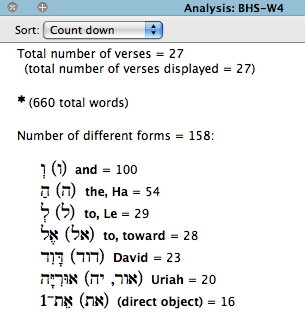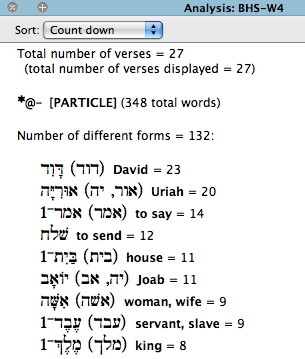This week we’ve been discussing the interpretive value of looking for repeated words in a passage of Scripture, and I’ve been showing how to do this using Accordance’s highlighting tools and other shortcuts. Going through a passage inductively and highlighting like that is a great way to discover key words in context, but it takes time. In the past couple of posts I’ve shown how you can speed up this process by doing individual searches and highlighting the hits, but you can save even more time by doing a search for all the words in a passage and analyzing the results to see which words are used most frequently. Up to now, we’ve been working through an English translation, but today I’ll be working with the Hebrew text directly.
To search for every word in the Hebrew Bible, I’ll set my search text to BHS-W4, click the Words button, and enter an asterisk (*) in the search field. The asterisk is a wildcard symbol which, by itself, simply means “find every word.” To limit this search to 2 Samuel (the passage we’ve been studying), I need to create a range in the range pop-up menu of the Search window. (NOTE: Because of a difference in the way the RANGE command works, I can’t use the RANGE command in this instance. I’ll explain that in more detail in a future post.) When I run this search, every word in 2 Samuel 11 will be highlighted.
At first glance, a search for every word in a passage may seem kind of pointless. But now that we’ve found every word, we can use Accordance’s statistical tools to analyze the search results. To do that, choose Analysis from the Details pop-up menu.
An Analysis tab will open listing every word that was found by this search. To see which words are used most frequently, I need only change the sort pop-up menu from Alphabetical to Count down.
As you can see, the most frequently used words are Hebrew particles like prepositions, articles, and conjunctions. If I’d like to filter these from the list so I can more easily focus on significant words, I can go back to my wildcard search and exclude the particles by adding an at symbol (@), a minus sign (-), and selecting Particle from the Enter Tag submenu of the Search menu. In the dialog box that appears, I could specify a particular type of particle, or I could simply click OK to exclude all particles. My search should now look like this:
The Analysis window will automatically update to reflect the new search, and should now look like this:
As you can see, I now have a list of all the Hebrew words which get repeated in 2 Samuel 11, and I can immediately begin drawing conclusions about this passage. For example, we see immediately that David and Uriah are the most frequently mentioned characters, but where is Bathsheba? This is supposed to be the story of “David and Bathsheba,” but Bathsheba is only mentioned by name one time. The rest of the time she is mentioned as “the woman” or “the wife” of Uriah. Is this an indication that the narrator is more interested in setting up a contrast between David and Uriah than in detailing David’s illicit relationship with Bathsheba?
Or notice the frequency of the verb “to say”? Seeing this might prompt us to examine how the narrative progresses through the dialog of the characters themselves.
We’ve already seen how frequently words like “to send” and “house” are used in this passage, but if we didn’t know that already, we would clearly see it in this analysis.
As you can see, searching and analyzing all the words in a passage can alert us to important words and concepts in a matter of seconds. By relying on these kinds of tools to speed up the process of observation, we can better concentrate our efforts on the tasks of interpretation and application.




